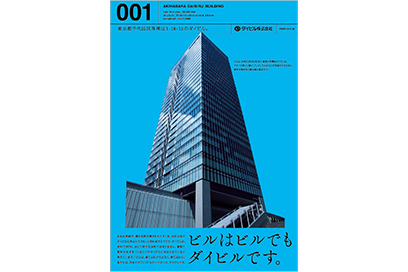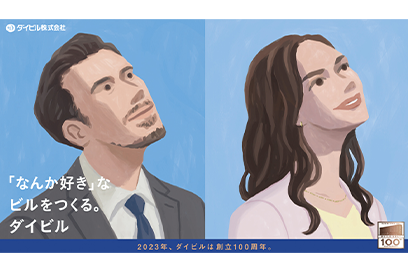
Chapter 5 Transformation
2004
2023
Section 5. Harmonious Coexistence with Society
8. Launching the Brand Development Project
Daibiru began using the communication name “Daibiru” in 1989 and changed its name officially to Daibiru Corporation in 1991 along with the introduction of a new corporate identity. Even so, that was not sufficient for raising the company’s name recognition and public profile in Greater Tokyo. Accordingly, In June 2012, Daibiru launched the Brand Strategy Promotion Project in parallel with new initiatives to promote the development of the Daibiru brand in order to improve the strength of the brand. As part of this effort, an advertising campaign was conducted mainly in Greater Tokyo. It focused on the Nikkei Shimbun and various advertising media as well as the Tokaido Shinkansen bullet train and used the slogan “BIRU-WA BIRU-DEMO DAIBIRU DESU.*” This same slogan was used for the company’s 90th anniversary in 2013, and the company ran ads in newspapers to raise its public profile.
- This slogan means “It’s not just a building, it’s a Daibiru,” which expresses the pride we take in the fact that we don't simply construct buildings, but we also create towns and pioneer new eras.
-

BIRU-WA BIRU-DEMO DAIBIRU DESU.

We’ll create a building to your liking.
In July 2019, the Brand Strategy Committee was established to accelerate brand development even further, as the company began to consider what the Daibiru brand should be given the significant changes taking place in the business environment. The Brand Strategy Committee went into full swing, launching an action declaration workshop, a roundtable with the company president, and an in-house social networking platform called Yammer. Internal measures included the creation of a video and posters to raise awareness of the project under the title “KOE O DAINI! (Speak Up!) Project” and a deeper discussion on what kind of company Daibiru should be, what it should aim for, and how it should be viewed by the public.
In October 2022, in order to strengthen the Daibiru brand even further, the company launched new advertisements with the slogan “Daibiru: ‘NANKA SUKI’.”* The new advertisements expressed the company’s intention to go beyond functionality and reasonableness to create buildings and communities that are attentive to the feelings of each individual, even in a future where people’s values and working styles become increasingly diverse. It also incorporated the idea that Daibiru wants everyone who works in or visits Daibiru’s office buildings, hotels, and commercial buildings to experience more pride and enjoyment, and that those feelings should be tied into urban development.
- It is important for buildings to look beautiful and to be convenient, but we also want to offer people a sense of comfort, pride, and even excitement. This is the indescribable feeling we call “NANKA SUKI.”
-
1923 1944 Beginnings
-
Section 2. Launching a Building Management Business
-
Section 4. Business Development in Wartime
-
1945 1957 Reconstruction
-
Section 2. Our Buildings Reopen
-
1958 1988 Development
-
Section 1. Expanding the Building Management Business
- 1. The End of the Requisition of the Hibiya Daibiru Buildings
- 2. Upgrading the Facilities of the Daibiru Buildings and Damage Caused by the 2nd Muroto Typhoon
- 3. The Completion of the North Wing of the Shin-Daibiru Building
- 4. The Completion of the Yaesu Daibiru Building
- 5. The Acquisition of the Midosuji Daibiru Building
- 6. The Completion of the Kojimachi Daibiru Building
- 7. The Completion of the Uchisaiwaicho Daibiru Building
- 8. The Completion of the Dojima Daibiru Building
- 9. The Completion of the Awajimachi Daibiru Building
- 10. The Completion of the Mita-Nitto Daibiru Building
-
Section 2. Expanding the Business Through M&A
-
-
1989 2003 Expansion (1989–2003)
-
Section 1. Creating New Urban Spaces
- 1. The Bubble Economy and Daibiru
- 2. The Hibiya Daibiru Rebuilding Project
- 3. The Completion of the Rebuild
- 4. The Start and Execution of Renovation Plans
- 5. The Completion of the Kita-Umeda Daibiru Building
- 6. The Completion of the Yodoyabashi Daibiru Building
- 7. The Completion of the Estate Tosabori Building
- 8. The Completion of the Umeda Daibiru Building
- 9. The Completion of Violette Takarazuka
- 10. The Shinjuku Daibiru Building and Shiba Daibiru Building Acquisitions
-
Section 2. The Development of a New Corporate Identity and a Name Change
-
Section 3. Disaster Preparedness and Risk Management
-
-
2004 2023 Transformation (2004–2023)
-
Section 1. Becoming a Consolidated Subsidiary of Mitsui O.S.K. Lines and Promoting Management Plans
- 1. Becoming a Consolidated Subsidiary of Mitsui O.S.K. Lines
- 2. Concentrating Investment in the Tokyo Area
- 3. Expanding into Other Countries and Japanese Regions
- 4. Establishing Daibiru 3D-Project Phase I, a Medium-Term Management Plan
- 5. Establishing Our Management Philosophy and Mission Statement
- 6. Establishing Daibiru-3D Project Phase II, a New Medium-Term Management Plan
- 7. Ongoing Establishment of New Medium-Term Management Plans
-
Section 2. Expanding Our Business
- 1. The Akihabara Station Redevelopment Project and the Completion of the Akihabara Daibiru Building
- 2. The Acquisition of the Toranomon Daibiru Building
- 3. The 3 Nakanoshima Joint Development Project and the Completion of the Nakanoshima Daibiru Building
- 4. The Completion of the Tosabori Daibiru Building
- 5. The Acquisition of Aoyama Rise Square
- 6. The 3 Nakanoshima Joint Development Project and the Completion of the Daibiru-Honkan Building
- 7. Rebuilding the Shin-Daibiru Building
- 8. Renovation Work
- 9. Multiple Awards
- 10. Delving into Commercial Facilities
- 11. Acquiring a Partial Interest in the Seavans South Building
- 12. Expansion to Sapporo
- 13. Selling Seven Residential Properties
- 14. Starting the Rebuild of the Midosuji Daibiru Building
- 15. Starting the Rebuild of the Yaesu Daibiru Building
-
Section 3. Overseas Business Expansion
-
Section 4. Further Strengthening of the Corporate Structure and Group Reorganization
-
Section 5. Harmonious Coexistence with Society
- 1. Developing a Compliance System
- 2. Developing an Internal Control System
- 3. Risk Management Measures
- 4. Sustainability Initiatives
- 5. Social Contribution and Cultural Support Initiatives
- 6. Environmental Initiatives
- 7. Working Style Reform Initiatives
- 8. Launching the Brand Development Project
- 9. Launching the Head Office Renovation Project
-
Section 6. Toward Our 100th Anniversary and Beyond
- 1. Becoming a Full Subsidiary of Mitsui O.S.K. Lines
- 2. Acquiring a Partial Interest in Otemachi First Square
- 3. Acquiring a Partial Interest in the Otemon Tower / ENEOS Building
- 4. Investment in an SPC for Logistics Facilities in the Nishinomiya Area
- 5. Project Participation in the United States
- 6. Project Development in Melbourne, Australia
- 7. Formulation of a New Medium- and Long-Term Management Plan
- 8. Implementing 100th Anniversary Projects
- 9. For Future Generations
-



